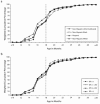Effects of maternal and provider characteristics on up-to-date immunization status of children aged 19 to 35 months
- PMID: 17194865
- PMCID: PMC1781415
- DOI: 10.2105/AJPH.2005.076661
Effects of maternal and provider characteristics on up-to-date immunization status of children aged 19 to 35 months
Abstract
Objectives: We examined the effects of maternal and provider characteristics on the up-to-date immunization status of children.
Methods: We used data from the 2003 National Immunization Survey to determine variations in children's up-to-date status in the 4:3:1:3 immunization series.
Results: Low maternal educational levels and low socioeconomic status were associated with high 4:3:1:3 series completion rates. Also, completion rates were high in Hispanic and non-Hispanic Black families with low income-to-poverty ratios.
Conclusions: We found that children of less educated mothers and children in Hispanic and non-Hispanic Black families with low income-to-poverty ratios were more likely to have completed the 4:3:1:3 series. Although the reasons for these results need further exploration in other data sets, possible factors are Hispanics' positive cultural attitudes regarding the needs and importance of young children and provision of information on immunizations to low-income minority mothers who access government-subsidized health care programs.
Figures

Similar articles
-
Changes in parents' perceptions of infant influenza vaccination over two years.J Natl Med Assoc. 2007 Jun;99(6):636-41. J Natl Med Assoc. 2007. PMID: 17595932 Free PMC article.
-
Maternal characteristics associated with vaccination of young children.Pediatrics. 2003 May;111(5 Pt 2):1215-8. Pediatrics. 2003. PMID: 12728141
-
The causes of racial and ethnic differences in influenza vaccination rates among elderly Medicare beneficiaries.Health Serv Res. 2005 Apr;40(2):517-37. doi: 10.1111/j.1475-6773.2005.00370.x. Health Serv Res. 2005. PMID: 15762905 Free PMC article.
-
Ethnocultural variations in the prevalence and impact of childhood chronic conditions.Pediatrics. 1993 May;91(5 Pt 2):1031-9. Pediatrics. 1993. PMID: 8479828 Review. No abstract available.
-
Immunization among African American children: implications for social work.Health Soc Work. 1996 May;21(2):105-14. doi: 10.1093/hsw/21.2.105. Health Soc Work. 1996. PMID: 8722137 Review.
Cited by
-
Clinical quality performance in U.S. health centers.Health Serv Res. 2012 Dec;47(6):2225-49. doi: 10.1111/j.1475-6773.2012.01418.x. Epub 2012 May 17. Health Serv Res. 2012. PMID: 22594465 Free PMC article.
-
Mind the Gap: What explains the education-related inequality in missed opportunities for vaccination in sub-Saharan Africa? Compositional and structural characteristics.Hum Vaccin Immunother. 2018;14(10):2365-2372. doi: 10.1080/21645515.2018.1460985. Epub 2018 May 11. Hum Vaccin Immunother. 2018. PMID: 29630441 Free PMC article.
-
Austerity, measles and mandatory vaccination: cross-regional analysis of vaccination in Italy 2000-14.Eur J Public Health. 2019 Feb 1;29(1):123-127. doi: 10.1093/eurpub/cky178. Eur J Public Health. 2019. PMID: 30215716 Free PMC article.
-
Epidemiology of vaccine hesitancy in the United States.Hum Vaccin Immunother. 2013 Dec;9(12):2643-8. doi: 10.4161/hv.27243. Epub 2013 Nov 18. Hum Vaccin Immunother. 2013. PMID: 24247148 Free PMC article. Review.
-
The effect of maternal decisional authority on children's vaccination in East Asia.PLoS One. 2018 Jul 12;13(7):e0200333. doi: 10.1371/journal.pone.0200333. eCollection 2018. PLoS One. 2018. PMID: 30001397 Free PMC article.
References
-
- Centers for Disease Control and Prevention. Ten great public health achievements—United States, 1900–1999. MMWR Morb Mortal Wkly Rep. 1999; 48:241–243. - PubMed
-
- Rodewald LE, Szilagi PG, Shiuh T, Humiston SG, LeBaron C, Hall CB. Is underimmunization a marker for insufficient utilization of preventive and primary care? Arch Pediatr Adolesc Med. 1995;149:393–397. - PubMed
-
- Centers for Disease Control and Prevention. Vaccination coverage among children enrolled in Head Start programs and licensed child care centers and entering school—United States and selected reporting areas, 1999–2000 school year. MMWR Morb Mortal Wkly Rep. 2001;50:847–855. - PubMed
-
- Healthy People 2010: Understanding and Improving Health and Objectives for Improving Health. 2nd ed. Washington, DC: US Dept of Health and Human Services; 2000.
-
- Office of Disease Prevention and Health Promotion. Healthy people 2010. Available at: http://www.health.gov/healthypeople/about/hpfact.htm. Accessed May 31, 2005.
MeSH terms
LinkOut - more resources
Full Text Sources
Medical

